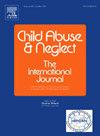Associations between child maltreatment and depressive symptoms among deaf and hearing adolescent students: A moderated mediation model
IF 3.4
2区 心理学
Q1 FAMILY STUDIES
引用次数: 0
Abstract
Background
Childhood maltreatment is a well-established risk factor for adolescent mental health issues, particularly depressive symptoms. Deaf adolescents face heightened vulnerability due to unique challenges such as communication barriers and social exclusion. However, little is known about how social exclusion mediates the relationship between childhood maltreatment and depression in this population, or how emotion regulation strategies moderate these effects.
Objective
This study aimed to examine the associations between childhood maltreatment and depressive symptoms in deaf and hearing adolescents, with a focus on the mediating role of social exclusion and the moderating effects of cognitive reappraisal and expressive suppression.
Participants and setting
A total of 2008 adolescent students (622 deaf, 1386 hearing) aged 12–23 years were recruited from six schools in China, including both mainstream and special education institutions.
Methods
Participants completed self-report measures assessing childhood maltreatment, social exclusion, emotion regulation strategies (cognitive reappraisal and expressive suppression), and depressive symptoms. Correlation analysis was conducted to examine variable associations, and an exploratory network analysis supplemented the main analyses by visualizing group-specific relationships. The core hypothesis was tested using a moderated mediation model to examine whether social exclusion mediated the relationship between childhood maltreatment and depressive symptoms and whether emotion regulation moderated these pathways.
Results
Deaf adolescents reported significantly higher levels of childhood maltreatment, social exclusion, expressive suppression, and depressive symptoms compared to their hearing peers (all p < .001). Social exclusion mediated the relationship between childhood maltreatment and depressive symptoms in both groups, with a stronger indirect effect among deaf students than hearing students. Expressive suppression moderated this relationship differently in the two groups: it exacerbated depressive symptoms among deaf students (β = 0.14, p = .002) but had a buffering effect among hearing students (β = −0.04, p = .04). Cognitive reappraisal showed limited protective effects in either group.
Conclusions
These findings highlight social exclusion as a key mediator linking childhood maltreatment to depressive symptoms, particularly among deaf adolescents. Expressive suppression exacerbated depressive symptoms in deaf students but buffered symptoms among hearing peers, suggesting that interventions should specifically aim to reduce reliance on expressive suppression in deaf adolescents. Although cognitive reappraisal showed limited protective effects in the current study, it remains an important strategy warranting further exploration in targeted interventions.
儿童虐待与失聪和听力健全青少年学生抑郁症状的关系:一个有调节的中介模型
儿童虐待是青少年心理健康问题,特别是抑郁症状的一个公认的危险因素。由于交流障碍和社会排斥等独特挑战,失聪青少年面临着更大的脆弱性。然而,对于社会排斥如何在这一人群中调解儿童虐待和抑郁症之间的关系,或者情绪调节策略如何调节这些影响,人们知之甚少。目的探讨童年虐待与失聪青少年抑郁症状的关系,探讨社会排斥的中介作用以及认知重评价和表达抑制的调节作用。研究对象和环境本研究从中国6所学校(包括主流教育机构和特殊教育机构)共招募了2008名12-23岁的青少年学生,其中聋人622人,健全人1386人。方法参与者完成儿童虐待、社会排斥、情绪调节策略(认知重评和表达抑制)和抑郁症状的自我报告。相关分析用于检验变量间的关联,探索性网络分析通过可视化群体特定关系来补充主要分析。我们使用一个有调节的中介模型来检验核心假设,以检验社会排斥是否介导了儿童虐待和抑郁症状之间的关系,以及情绪调节是否调节了这些途径。结果失聪青少年报告的童年虐待、社会排斥、表达抑制和抑郁症状的水平显著高于正常同龄人(p <;措施)。社会排斥在两组儿童虐待与抑郁症状的关系中起中介作用,聋哑学生的间接作用强于听力正常学生。在两组中,表达抑制对这一关系的调节作用不同:在聋哑学生中,表达抑制加重了抑郁症状(β = 0.14, p = 0.002),而在听力正常学生中,表达抑制有缓冲作用(β = - 0.04, p = 0.04)。认知重评在两组中均显示出有限的保护作用。结论:这些发现强调社会排斥是儿童虐待与抑郁症状之间的关键中介,特别是在失聪青少年中。表达抑制加重了失聪学生的抑郁症状,但缓冲了听力正常的同龄人的症状,这表明干预措施应专门针对减少失聪青少年对表达抑制的依赖。尽管认知重评价在当前研究中显示出有限的保护作用,但它仍然是一个重要的策略,值得进一步探索有针对性的干预措施。
本文章由计算机程序翻译,如有差异,请以英文原文为准。
求助全文
约1分钟内获得全文
求助全文
来源期刊

Child Abuse & Neglect
Multiple-
CiteScore
7.40
自引率
10.40%
发文量
397
期刊介绍:
Official Publication of the International Society for Prevention of Child Abuse and Neglect. Child Abuse & Neglect The International Journal, provides an international, multidisciplinary forum on all aspects of child abuse and neglect, with special emphasis on prevention and treatment; the scope extends further to all those aspects of life which either favor or hinder child development. While contributions will primarily be from the fields of psychology, psychiatry, social work, medicine, nursing, law enforcement, legislature, education, and anthropology, the Journal encourages the concerned lay individual and child-oriented advocate organizations to contribute.
 求助内容:
求助内容: 应助结果提醒方式:
应助结果提醒方式:


